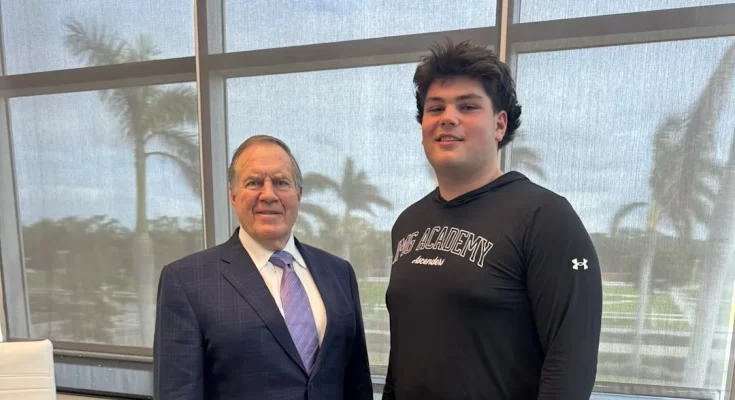Title: From Sooner to Tar Heel: The Journey of a Rising Offensive Lineman
In the world of college football, the offensive line is often called the “trenches”—a place where grit, determination, and raw power collide on every snap. While skill positions and flashy plays often grab headlines, the offensive lineman’s role is foundational. It’s in the trenches where games are won or lost, where champions are built, and where character is forged.
This story is about one such player—a rising offensive lineman who began his journey at the University of Oklahoma but recently made the bold decision to transfer to the University of North Carolina. His name is Malik Thompson*, and his journey embodies the modern college athlete’s pursuit of growth, opportunity, and identity.
The Early Days: A Sooner Born and Raised
Malik Thompson grew up in Tulsa, Oklahoma, in a football family. His father, a former high school coach, introduced him early to the sport, teaching him the fundamentals of blocking and footwork before most kids knew how to throw a spiral.
From a young age, Malik’s size and agility stood out. By his sophomore year of high school, he was already a dominant force on the offensive line, earning all-state honors and attracting attention from top programs across the nation. But for Malik, Oklahoma was home—not just geographically but culturally.
“When I was a kid, I dreamed of putting on that crimson and cream,” Malik said in an interview. “Oklahoma football is everything in my family. It’s tradition, passion, and pride.”
His commitment to the Sooners came as no surprise. Ranked as a four-star recruit, Malik signed with Oklahoma after a high-profile recruitment that included offers from powerhouse programs in the SEC and Big Ten.
The Sooners Experience: Growth Amidst Challenges
Malik’s first two years at Oklahoma were a mix of excitement, hard work, and adaptation. The Sooners, under their then-head coach, had a storied tradition of producing elite offensive linemen who thrived in both college and the NFL. Malik was eager to follow in those footsteps.
However, the transition to college football brought unexpected challenges. The speed and complexity of the game increased dramatically. Malik found himself competing against older, more experienced players for playing time.
“I knew it wasn’t going to be easy,” Malik reflected. “But I thought if I worked hard enough, the opportunities would come.”
He improved steadily, contributing primarily on special teams and in rotation during his freshman year. By his sophomore season, Malik was pushing for a starting role, but the depth chart was deep, and competition fierce. Injuries and coaching changes also complicated his development.
Despite the challenges, Malik credits his time at Oklahoma for shaping his toughness and work ethic. “Oklahoma football is demanding. It tests you mentally and physically every day,” he said. “I grew a lot there, no doubt.”
The Transfer Decision: Seeking New Horizons
Still, by the end of his sophomore year, Malik began to question his path. The Sooners were going through a coaching transition, and the new staff’s offensive system and player development philosophy didn’t fully align with his style and strengths.
More importantly, Malik wanted a clearer path to playing time and a chance to showcase his skills on a national stage to prepare for the NFL Draft. After careful consideration and conversations with family, mentors, and coaches, he made the difficult decision to enter the transfer portal.
“I had to be honest with myself,” Malik said. “I love Oklahoma, but I needed an environment where I could reach my potential and play the way I know I can.”
The decision shocked many fans and analysts who saw Malik as a cornerstone of Oklahoma’s future line. But transfers are increasingly common in today’s college football landscape, where players seek the best fit for their careers.
Why North Carolina?
Among the schools expressing interest, North Carolina stood out for several reasons.
First, the Tar Heels’ offensive line coach, Coach Greg Thompson (no relation), had a reputation for developing linemen into NFL-ready players. The UNC program emphasized a balanced, pro-style offense that suited Malik’s strengths as a powerful run blocker with good agility.
Second, the opportunity for immediate playing time was clear. UNC was looking to rebuild its offensive line and welcomed a player of Malik’s caliber to step into a starting role quickly.
Finally, Malik was drawn to the culture and academics at UNC. “North Carolina is a special place,” he said. “It’s a program on the rise, and the community support is amazing. Plus, I want to challenge myself academically and personally.”
The move would also mean a significant geographic and cultural change—from the heartland of Oklahoma to the coastal South—but Malik embraced the challenge.
Adjusting to Life as a Tar Heel
Since enrolling at UNC in the spring semester, Malik has been busy adapting both on and off the field.
On the field, he has impressed coaches and teammates with his work ethic and leadership. “Malik brings a level of maturity and toughness that this line needs,” said Coach Thompson. “He’s not just talented; he’s a competitor.”
Malik has been working on improving his footwork and pass protection to fit UNC’s offensive schemes better. “The coaches are really invested in helping me grow,” he said. “I’m learning every day.”
Off the field, Malik is enjoying the new environment. Chapel Hill’s vibrant college town atmosphere and proximity to the Atlantic coast provide a refreshing change from Oklahoma’s plains. He’s also embracing the academic opportunities, pursuing a degree in business administration.
The adjustment hasn’t been without its difficulties. Leaving behind his hometown, friends, and family was emotionally tough. But Malik remains confident that this move will be beneficial in the long run.
The Bigger Picture: The Transfer Trend in College Football
Malik’s journey is part of a larger trend reshaping college football—the increased use of the transfer portal. Once rare, transferring is now a strategic tool for players seeking better fits, playing time, or developmental opportunities.
For offensive linemen, the transfer portal can be a game-changer. These players often mature later and benefit from finding a system that maximizes their unique skills.
North Carolina has positioned itself well to attract talent like Malik, combining strong coaching, competitive football, and a supportive academic environment.
What’s Next for Malik?
Looking ahead, Malik has clear goals.
He wants to help North Carolina build a dominant offensive line and contribute to a winning program. On a personal level, he aims to refine his skills, earn All-ACC honors, and elevate his draft stock for the NFL.
“I’m here to compete and improve,” Malik said. “I want to be the best player and teammate I can be.”
His journey—from a hometown hero in Oklahoma to a rising star in Chapel Hill—is just beginning, but it exemplifies the resilience, adaptability, and ambition that define today’s college athletes.
Malik Thompson’s transfer from Oklahoma to North Carolina is more than just a change of jersey; it’s a testament to the evolving nature of college football and the pursuit of opportunity.
In the trenches, every snap is a battle. For Malik, the battle has taken him from the heart of the Sooner State to the shores of North Carolina—but his determination to succeed remains steadfast.
As the Tar Heels prepare for their upcoming season, all eyes will be on Malik—a player whose story reflects the passion, sacrifice, and hope at the core of college football.
If you want, I can help expand any section or create a specific angle like a coach’s interview, scouting report, or a game scenario. Just let me know!



